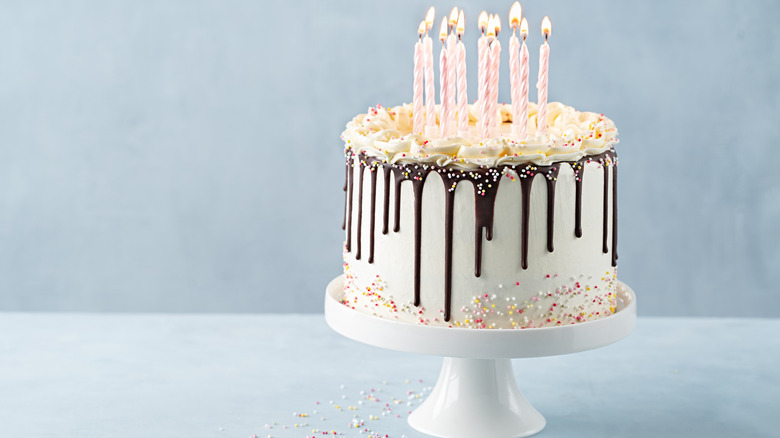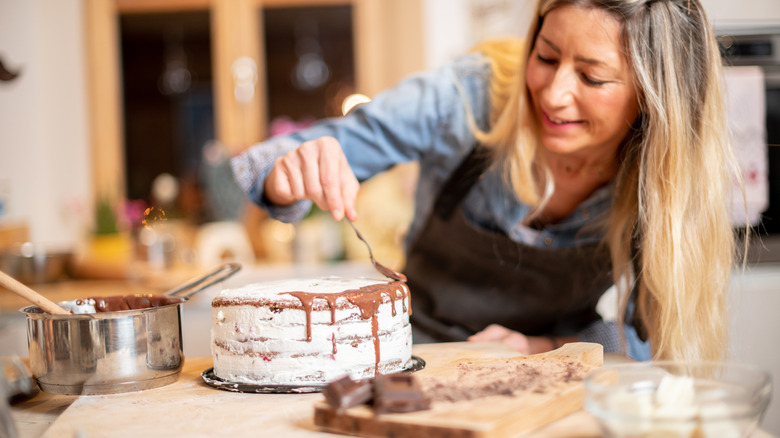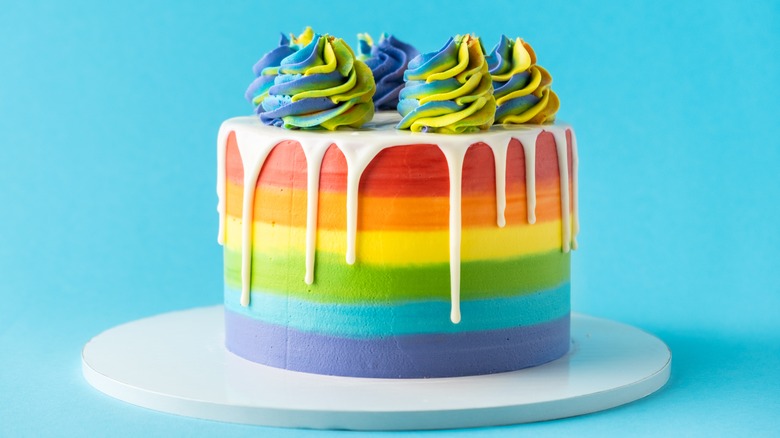The Simple Trick For A Perfect Frosting Drizzle On Your Next Cake
A cake is not just a cake when it's also a work of art. Whether your cake decorating abilities are limited to wondering "What is fondant?" or if you can skillfully pipe on tulips alongside the pros, you can easily add frosting drizzle to your list of talents. Sure, it takes a little practice to curate the most natural-looking drip, but one tool that will help is easily found in any kitchen — a spoon.
The beauty of any drip cake is the perfectly imperfect nature of the drizzle runoff. It's a type of decoration that makes a statement without a lot of pomp and circumstance. It brings color that can range from a standard chocolate ganache to a glistening metallic gold fit for the royalty in your household. Cake drizzle also imbues textural contrast with a raised drip standing out against a smooth background. Plus, your drip helps marry flavors throughout the layers, whether you're making a dark chocolate cake with red wine glaze or a Mexican chocolate cake with a cinnamon glaze.
The spoon trick
Creating a drip frosting on your cake doesn't require fancy tools. All you really need is a standard spoon from your utensils set. With one or two teaspoons of glaze on board, the spoon holds an adequate amount for making long or short drips. A spoon also gives you control over the flow of the drizzle. With the spoon straight up and down, the topping will flow quickly, but by rotating the spoon handle back a bit, the liquid flow will slow. You can also use the rounded edge of the spoon to gently nudge the glaze and guide it where you want it to go.
The spoon is a handy choice since it eliminates the need to transfer your glaze into a piping bag or squeeze container — and have to clean the squeeze container out. Best of all, this spoon trick works with all types of frosting, from a simple powdered sugar glaze to a glaze made from store-bought icing.
Other drizzle application tips
While a spoon is effective in achieving drip results, there is more to the practice than the tool you use. The art is in the technique, which requires starting your drizzle from the top of the cake so it can run down the sides like an overflowing fountain.
It's also essential that your glaze is the right consistency. If it's too thin, it will run down the cake in a narrow streak. On the other hand, if it's too thick, it will gel to the side without creating a drip effect. Test your glaze on a glass or other similar surface to evaluate the thickness and performance. It's best to make adjustments before trying it out on your cake's surface.
When using a spoon to transfer your glaze from the bowl to the cake, watch for drips so you don't unintentionally create blob or splatter decorating effects. Also, play around with the quantity of drizzle on your spoon so you can control both long and short drips for variety in the finished look. And if you plan to get creative with cake toppings, be sure to apply your drizzle first and let it set before adding your edible decorations.


